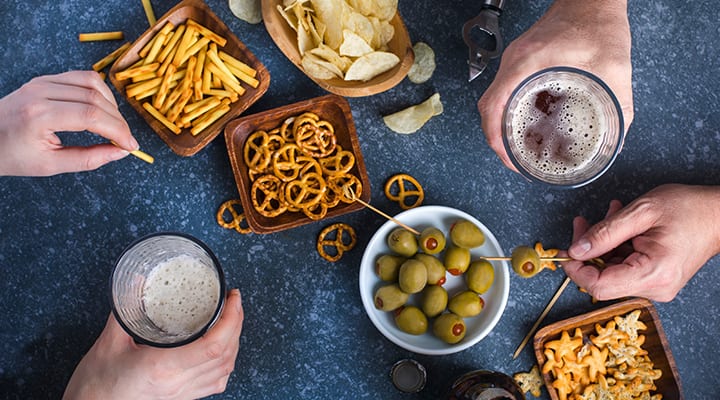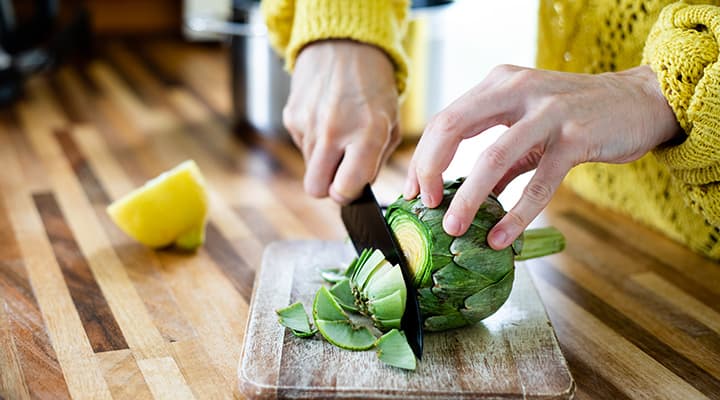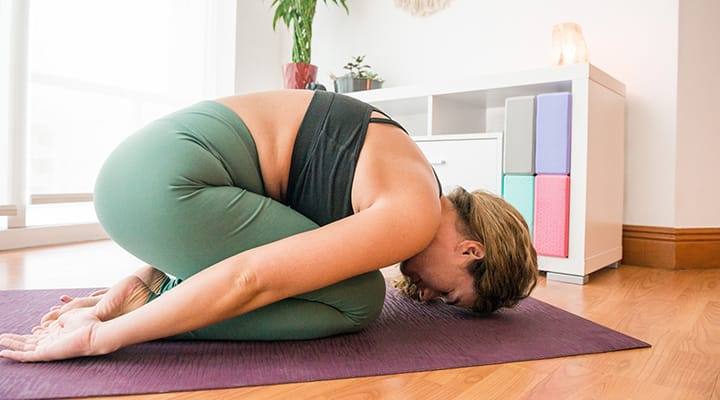
Bloating vs. Belly Fat: Why is Your Abdomen Getting Enlarged?
Published: July 2022
The midsection is one of the most challenging areas to keep slender. Most of us struggle with some sort of pooch, bulge, or “muffin top.” What makes it even trickier is that you might not even know if you’re dealing with a bloated stomach (which, to get technical, is actually not your “stomach” but occasional gas in your intestines) or excess fat around your abdomen.
So let’s get to the belly of the beast and discuss bloating vs fat, how you can tell the difference, and how to get a slimmer waist.
A bloated stomach or fat gain: How to tell
It’s the end of a long day. You’re standing in front of your bathroom mirror and turn to the side, and… what’s this? Your belly looks bigger. It’s jutting out and looks more rounded. But you’re not quite sure what it is. How can you tell the difference between a stomach that looks bigger due to water retention, occasional gas…or actual fat gain?
Consider these factors:
How do you look in the morning?
When you wake up, you were technically fasting the entire time you were sleeping. If your stomach is flatter in the morning and bigger before bedtime, it’s not from fat gain.How does it feel?
On the other hand, if your belly is soft to the touch and you don’t feel any discomfort, it probably is fat.What is the scale doing?
If you’re retaining water (which can make you look bloated) then the number on the scale can go up quickly—even within the same day. Fat gain, on the other hand, coincides with a more gradual increase on the scale. (Interesting fact: if occasional gas rather than water is what’s causing the bloating, you shouldn’t see any change on the scale at all.)What’s happening in the bathroom?
If you haven’t had an, ahem, bowel movement lately, and your belly is looking bigger, it’s pretty safe to say that you’re dealing with a temporary situation.
Going through these questions will help you better understand bloating vs. fat. It’s also important to be in touch with how you feel. Do you experience one or more of the following?
- Feelings of increased abdominal pressure
- Feelings of fullness
- Occasional discomfort
- Abdominal distension
While most of these are subjective, visible distention in the abdomen can mean there is something going on inside the gut and that it’s not weight gain (belly fat), or “water weight.”
What causes bloating?
If you’re bloated, there’s a pretty decent chance that the cause is your gut microbes reacting to food you’ve eaten—which can happen when the food contains a lot of simple sugars or plant fibers, among other types of foods that can trigger bloating. (Dairy is another common cause.) Your GI tract fills up with air or occasional gas in response to the increase of the “bad” bacteria.
That’s not the only reason why people get bloated from occasional gas, though. Here are some other culprits behind a bloated belly:
- Swallowing air: We swallow air when we do things like smoke, eat too fast, or chew gum. (Pro tip: Slow down and eat mindfully to enjoy your food before and after a meal.)
- Pop/carbonated drinks: True, you burp some of this occasional gas away. However, once it hits your intestines, it’s there until you pass it. And don’t forget that many sodas contain simple sugars.
- Overeating: Your stomach has a volume of about 2.5 ounces when it’s empty. And it can expand to contain about a quart of food. Overeating beyond this might lead to feeling bloated. It’s important to get to the root cause of why you overeat, although appetite suppressants can help.
- Lack of bowel movements: We all experience occasional constipation now and again. It can be caused by stress, dehydration, or something you ate (or didn’t eat, like fiber!).
Many people use the word “bloating” to refer to water retention. Water retention causes of bloating (which will affect not just your abdomen, but other parts of your body, too):
- Eating too much salt: Your body needs it. However, too much of a good thing can be a bad thing. Salt causes water retention, which can lead to bloat.
- Air travel: Changes in cabin pressure and sitting for long periods of time can make the waistband of your jeans feel uncomfortably tight; it can also make your shoes and rings feel too snug.
Things that cause bloating due to both water retention and occasional gas:
- Eating too many quick carbs: We mentioned before that simple/quick carbs — like white bread, pastries, and pop — can make you bloated because they can contribute to an imbalance in your gut bacteria. That’s only one reason why your carb intake might contribute to a less-than-lean looking belly. Some carbs can also make you hold on to water, too.
- Menstruation and PMS: Changes in progesterone and estrogen levels can cause the body to hang onto more water and salt. And, some women are more likely to deal with occasional gas and digestive impacts during specific phases of their menstrual cycle. Talk about a double whammy!
Of course, beyond bubblegum, salty meals and PMS, there are very serious reasons for both water retention and occasional gas–if your bloating isn’t just an occasional annoyance, reach out to your doctor and dietitian! Keeping a detailed food diary can help your healthcare practitioner help you.
What causes abdominal fat gain?
Fat gain in your abdomen—and anywhere else—is likely a result of eating an excess of calories. While this is a simplified explanation, if you consume more than your body burns, you’re going to have excess fat. It’s not solely about the calories you eat, though. Other weight gain factors include your:
- Age
- Sleep habits
- Activity level
- Hormone levels and activity
- Certain medications
How to relieve bloating
Now that you know more about what causes bloating, let’s talk about how to avoid or eliminate it. Meal size, frequency, texture, and the type and amount of fiber foods contain can all play a role in bloating.
A good starting point is to avoid or limit foods that are considered FODMAP, an acronym standing for Fermentable Oligosaccharides, Disaccharides, Monosaccharides and Polyols. You might find that cutting one or several items on this list eliminates your bloating altogether.
FODMAPS include:
- Dairy
- Wheat products (cereals, breads, crackers)
- Beans and lentils
- Garlic
- Certain vegetables including asparagus and onions
- Certain fruits such as cherries, apples, peaches and pears
Avoiding simple sugars and limiting cruciferous vegetables is also a good idea if bloating has been a problem for you.
Foods to relieve bloating and occasional gas
On the other hand, certain foods can provide bloating relief. This list isn’t exhaustive, but here are some suggestions!
- Artichoke. This flavorful, flowery vegetable promotes healthy bile flow from the liver to keep things moving.
- Fennel. Enjoyed as both a vegetable and an herb, fennel has been used for generations to relieve occasional indigestion and bloating. It’s particularly powerful when combined with turmeric: A large placebo-controlled clinical trial showed significant improvement in bloating and other digestive discomforts for people taking a combination of fennel seed oil and turmeric.
- Ginger. This sweet and tart spice promotes gastric emptying–which is key to bloating relief.
- Green tea. Green tea contains caffeine, which can stimulate the digestive system. Need another reason to sip? Green tea is packed with an antioxidant called epigallocatechin gallate (EGCG). This can promote a healthy inflammatory response. Green tea can also help you better control your appetite.
- Asparagus. Spear yourself some GI relief! Asparagus contains a prebiotic fiber called inulin. Inulin can help to support gut health and make you more regular, which can help you steer clear of stomach bloating.
- Oatmeal. Need a healthy-belly breakfast idea? Oatmeal is a high-fiber food, which helps you stay regular and can thus minimize bloating.
Psst! Have you taken our quiz on digestive health?
Digestive supplements
Certain digestive supplements can help you relieve bloating. Life Extension’s Bloat Relief contains artichoke extract, ginger extract, fennel seed oil and turmeric. Digestive enzymes help to break down the food you eat. Probiotics, green tea supplements and magnesium are also effective supplements for bloating.
Routines that help with bloating relief
Simple lifestyle changes can help with bloating relief, including:
- Move your body more. It can help you stay regular.
- Try yoga! Certain poses can encourage the release of occasional gas, like the child’s pose, happy baby pose, and squatting.
- Massage your abdomen. Put your hands just above your right hip bone, and rub in circles with light pressure upward toward your ribs. Then, rub straight across toward the left. Move down to the left hip bone. Repeat!
- Take a warm bath. Since this might help you relax, it can encourage your gastrointestinal tract to relax and function more optimally.
How to lose belly fat
If you determine that you’re experiencing weight gain and not bloating, losing weight is really the only way to reduce the size of your belly; unfortunately, there’s no way to spot-reduce an area. That being said, the following tips can help you lose fat everywhere…including your belly!
1. Best diets to lose abdominal fat
The most effective diet is the one you can stick to! This might be different for everyone. However, you might consider the Mediterranean diet. It contains balanced amounts of protein, healthy fats, and fiber, and is low in simple carbs. This plan also emphasizes nutrient-dense food from the earth and offers more than enough variety, so you don’t feel restricted and can more reasonably keep off excess fat.
2. Foods for a flat belly
The following foods can help you on your journey towards less belly fat:
- Fermented foods: Science suggests that foods which contain probiotics–which includes kimchi, sauerkraut and kefir–can help you lose weight and maintain it.
- Lean meats: Fish, chicken, and turkey are excellent sources of protein, which is vital for maintaining healthy body composition. (Don’t forget to take our supplement quiz on weight and body composition!)
- Whole grains: Yes, carbs can be good for you. Research shows that eating whole grains can boost your metabolism.
- Leafy greens: Your body wants you to eat your veggies. They’re packed with powerful micronutrients, fuel your body, and fill you up!
3. Fat burner supplements: How do they work?
Weight management supplements can help you better control and maintain the number on the scale. One type of supplement is an AMPK metabolic activator. Every cell in your body has an enzyme called AMPK. Over time, the levels of this enzyme decline, which can cause your body to store more fat. AMPK Metabolic Activator triggers the AMPK activity in your body, telling it to stop storing fat and start burning it for energy.
CLA and carnitine are also common fat-burners and can help keep your belly lean.
4. Routines that help lose fat around the abdomen
There are two main types of exercise routines that can help you stay lean and strong. The first is strength/resistance training. This helps build muscle, and the more muscle you have on your body, the more calories you burn.
The second is high-intensity interval training (or HIIT). Whereas running on the treadmill for 20 minutes is steady-state cardio, doing intervals of walking, jogging and sprinting is more effective at torching calories. HIIT has been found to reduce total and visceral fat mass. Visceral adipose tissue, which is distributed around body organs poses a higher risk to our health as compared to subcutaneous fat, which is present under the skin.
When it comes to the diet vs exercise debate around weight loss, what you do in the kitchen does factor in more heavily. However, you need both in order to be healthy and fit.
5. Belly belts and waist trainers: Gadgets to watch out for
Waist trainers make an exciting promise: Wear one and it’ll trim and shape your stomach. We hate to break it to you, but this isn’t how fat loss works. Shedding belly fat (which, again, comes from reducing overall body fat) requires a change in your nutrition, your activity, or, ideally, both. Waist trainers can’t do anything about fat accumulation.
Now that you know the main differences between bloating vs fat, you have a better idea of how to address them so you can get one step closer to your ideal body type. Eat well, get moving, and stay healthy!
References
- Bărboi, Oana-Bogdana et al. “Effect of inulin in the treatment of irritable bowel syndrome with constipation (Review).” Exp Ther Med., December 2020, https://www.ncbi.nlm.nih.gov/pmc/articles/PMC7579772/
- Rana, Sarika. “5 Side Effects of Green Tea: From Caffeine Overdose to Dehydration and More!” NDTV Food, August 2017, https://food.ndtv.com/food-drinks/5-side-effects-of-green-tea-from-caffeine-overdose-to-dehydration-and-more-1734964
- “Bloated Stomach.” Cleveland Clinic, https://my.clevelandclinic.org/health/symptoms/21740-bloated-stomach
- “New study finds that eating whole grains increases metabolism and calorie loss.” American Journal of Clinical Nutrition, February 2017, https://www.eurekalert.org/news-releases/892898
- “Why Do I Feel Bloated? Common Causes of Bloating — and What You Can Do About It.” Penn Medicine, February 2020, https://www.pennmedicine.org/updates/blogs/health-and-wellness/2020/february/common-causes-of-bloating
- “Stomach Capacity.” Alabama Public Health, https://www.alabamapublichealth.gov/perinatal/assets/StomachCapacity.pdf
Like what you read?
Please subscribe to get email updates on this blog.










